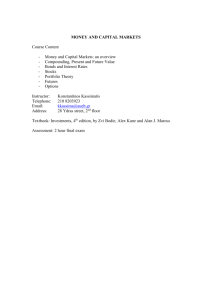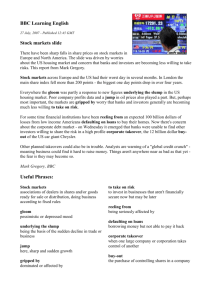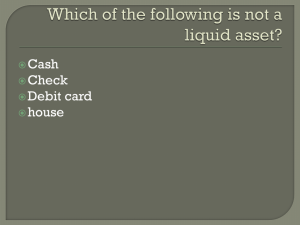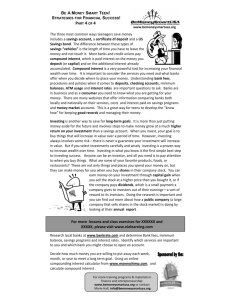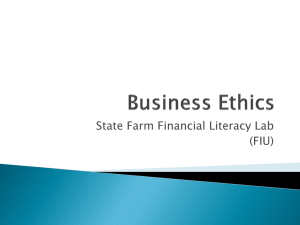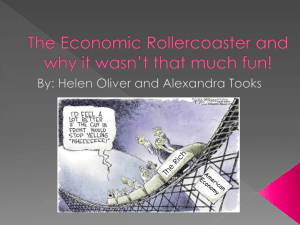the stock market crash and the great depression
advertisement
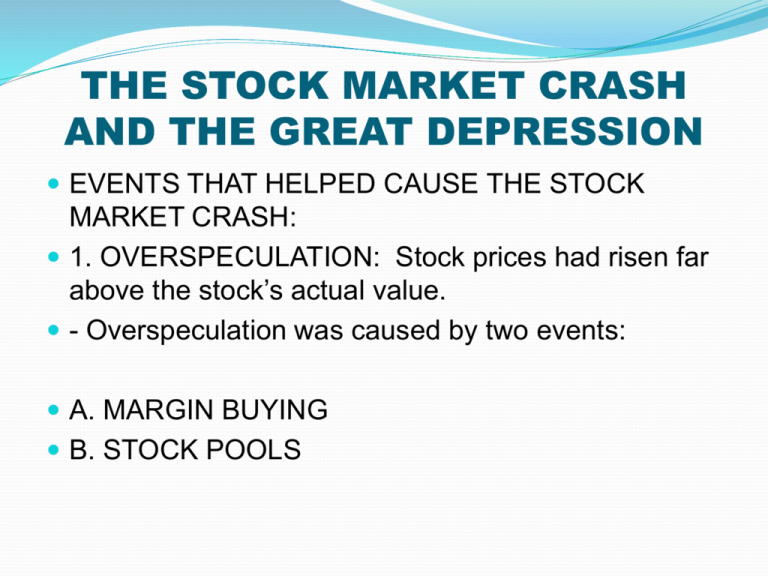
THE STOCK MARKET CRASH AND THE GREAT DEPRESSION EVENTS THAT HELPED CAUSE THE STOCK MARKET CRASH: 1. OVERSPECULATION: Stock prices had risen far above the stock’s actual value. - Overspeculation was caused by two events: A. MARGIN BUYING B. STOCK POOLS MARGIN BUYING Investors did not have enough money to purchase all of a stock. -They borrowed the remainder of the money (banks, credit unions, etc.) -This allowed people to invest money they did not have. -Demands for the stock rose. -Which caused stock prices to rise. (usually artificially high) STOCK POOLS A GROUP OF WEALTHY INVESTORS BOUGHT A LARGE BLOCK OF STOCK -They traded back and forth driving up the price of the stock. Other investors(common person) thought this was a good stock and wanted to buy it. At a certain point the stock pool would decide to sell the stock = the stock was now at a much higher price than it was really worth, and the stock pool would make a huge profit. STOCK POOLS CONTINUED -Prices of the stock would drop and the investors who bought it at a high price would lose their money. -The stock pool would than turn around and buy back the stock at a very cheap price and usually make a large amount of money. QUESTION = What happens when a person buys a stock at a very high price and is forced to sell it at a very low price? SECOND REASON FOR THE STOCK MARKET CRASH = ACTIONS BY THE FEDERAL RESERVE BOARD To promote economic growth the interest rate in banks and other lending institutions was lowered with the hope of getting more money into circulation. -The hope was that people would borrow money to build houses, start businesses, and industry. (Why is this good?) -Many people used the borrowed money get richquick schemes (gambling, stock market, etc.) This did not work. FEDERAL RESERVE BOARD CONTINUED: -In August of 1928 the FRB now decided to raise the interest rate in banks to keep people from borrowing money for the schemes. -Investors began to sell their stock which caused the prices to fall. Brokers and other investors began to panic and they began to sell. -This led to even more people selling and very few people buying. (Why is this bad?) PROBLEMS THAT LED TO THE GREAT DEPRESSION 1. UNEQUAL DISTRIBUTION OF WEALTH: The richest one percent of the population controlled 15 percent of the nations wealth. -They usually put their money into stocks and savings, not into circulation. WHY? - Why is this bad? -Many other people began to hide what little money they had. HIGH TARIFFS AND WAR DEBTS -This slowed trade and the ability for countries to pay back war debts. -Tariff = a tax on an imported good. WHY? -Countries could afford to sell products in the U.S. What did the countries do in response to the tariffs? -How did this hurt the U.S.? THE FARM CRISIS -During World War One farmers in the U.S. bought new land and new machinery. WHY? -How did they buy much of the land and machinery? -After the war the U.S. did not need all of the food produced by the farmers which caused many farmers to have financial trouble. -WHY WAS THE FOOD NOT NEEDED? -WHY WAS THERE FINANCIAL TROUBLE? OVERPRODUCTION The productive capability of the U.S. increased after World War I. -Wages did not keep pace with the prices of goods. People were not making as much money as they thought = they began buying products on credit. Eventually people could not afford to buy new products, since they were paying on old products. CREDIT = boost the economy in the short run, puts people in debt, reduces their buying power in the future. THE BANKING SYSTEM -The banking system was poorly managed and there were no government regulations on the banks. -By 1932 five thousand banks failed. (WHAT DOES THIS MEAN?) -In the first three years of the Great Depression nine million people lost their saving accounts. -Thousands of banks had to shut down because there were RUNS ON BANKS. (What is this?) THE DOMINO EFFECT Problems in one sector (area) eventually affected all the other sectors or areas. By 1932 twelve million of the eligible workers in the United States were out of work. In August of 1932 the unemployment rate hit 32% Many others who were working were barely making enough to survive. The Unemployment rate did fall below 10% until 1941.
